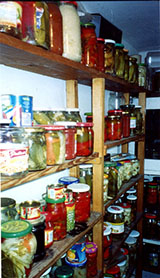Meats and Sausages
Storage of Canned Food
Canned food should be stored in a dry, cool place. Ideally, the storage area should have some air circulation, otherwise molds might grow on the outside of jars, screwbands, and metal cans might start to rust. Correct processing will kill spoilage bacteria and foods will not spoil, unless kept at temperatures over 95° F (35° C). At these temperatures certain heat loving microorganisms, which could have survived the canning process, might start growing again. Nevertheless, certain chemical reactions which affect fat rancidity, food texture, color and nutritional value may occur when proper storage conditions are not met. The best storage temperature is about 35-59° F (2-15° C), and the higher it is, the more unwelcome changes will occur in stored foods. As explained earlier, extremely high temperatures may create favorable conditions for thermophillic bacteria that survived heat treatment to grow and spoil the food. Freezing will affect texture quality due to water crystal formation inside of the food. This will make frozen food less palatable than properly stored canned food. Besides, this expansion of water may break glass jars and weaken the seals. Glass jars should be protected from light otherwise fats will develop rancidity and the quality of the product will suffer. At proper conditions meat and fish will keep well for 2-3 years. If jars must be kept in a very cold place, just insulate them by any practical means, for example, wrapping them in newspapers or keeping them in boxes covered with more newspapers or blankets. Store cans at room temperature. What we want to mention is that in many cases, for example in tropical countries, canned products might be kept at temperatures higher than 77° F (25° C). Although bacterial spores will be eliminated during proper processing times at 240° F (116° C), there are certain bacteria (thermophillic bacillus strains) which are extremely heat resistant and they will survive. They normally donít grow below 77° F (25° C), even if present in a sealed container. However, when storage temperatures will reach 95° F (35° C) or higher, those bacteria will grow and given time will spoil the food. To eliminate this possibility, the processing times and temperatures must be increased even more. It should be noted that those bacteria spoil the food only and donít pose grave risks to our safety.

















